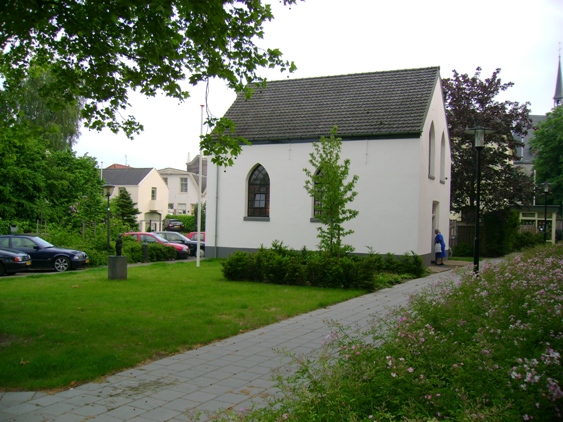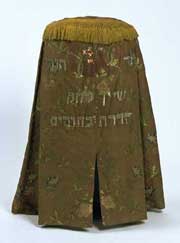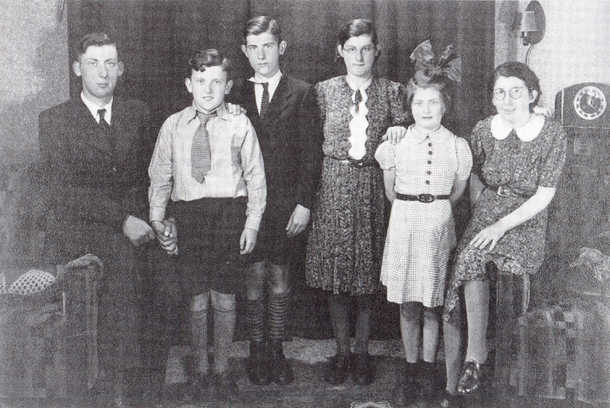The Jewish Community of Haaksbergen
List of names of genealogical relevance mentioned in the article (in order of appearance):
1) Till the end of the 18th century:
Samson the Jew(1691), Joseph the Jew, Borchard Levi (1739), Heiman the Jew, Salomon Coopman(1748), Meijer the Jew (senior), Moses the Jew, Meijer the Jew (junior), Isaak Levie the Jew, Isaak the Jew, Hartog the Jew (1764).
2) 19th century:
Moses Heiman (Northeimer)(1803), Juda Wolf Levi Bloemendal, Ozak de Jong (1825) , families de Jong and Frankenhuis, Meyer Nathan Versteeg (1840)
Introduction
The earliest data about Jews in Overijssel are from the first part of the 14th century.
They were mainly moneylenders, lending their money against interest.
The first mention of a Jew in Haaksbergen appears in 1691, Samson the Jew from Haaksbergen.
"One iron water bucket, four tin spoons, three chairs and one wheel, a board to cut vegetables, and two wooden salt shakers, all these from the household of Samson the Jew from Haaksbergen, have been sold as ordered by the judge to the highest bidder. With the proceeds of four guilders, sixteen "stuiver" and six penny, the back taxes of Samson are paid."
Since all occupations were forbidden, only the commerce in rags, hides and scrap metal was left to the Jews.
They also could be peddlers.
In 1739 the Provincial Government (the "Staten van Overijssel") decided that foreign or new Jews, or "Smousen," were not allowed in any way to live in the countryside making a living with a little shop, with slaughter, or with small commerce.
Those who had already a permit, could stay."All foreign, passing, walking, migrating, or circulating Jews or "Smousen," being pack carriers, peddlers, traders in old clothes, … are not allowed to stay overnight in the countryside, but before dark they … have to move to the closed towns."
Samson the Jew lived in a house at the Pijpenbrink; Joseph the Jew and Borchard Levi also lived there.
In 1748 there were two Jewish families in Haaksbergen. The family of Heiman the Jew and of Salomon Coopman.
The latter was a butcher, who in 1742 had married the daughter of Borchard Levi.
In 1764 there were already seven Jewish families. Meijer the Jew (senior), Moses the Jew, Meijer the Jew (junior), Isaak Levie the Jew, Isaak the Jew, Salomon Coopman and Hartog the Jew. All of them came from Germany.
In 1795 there lived in aaksbergen a total of 236 families, including ten Jewish families.
WWith the local population they spoke a Dutch dialect, but with each other they spoke Jiddish.
The remarkable difference with the non-Jewish population was that most of them were illiterate, while the Jewish population was able to read and study the Torah. In 1803 Moses Heiman (Northeimer) owned 35 Hebrew books.
Napoleonic laws
After the defeat of Napoleon in 1813, the ideals of "Freedom, Equality and Fraternity" remained in force.
In this way the Jews became Dutch citizens with all rights and obligations.
Amongst others the separation between church and state was a declared goal.
During those years however, the limitations imposed upon Jewish occupations did not change very much .
In 1808, during the reign of King Lodewijk Napoleon, a High Consistory was instituted,
which also remained in force during the reign of King Willem I.
The High Consistory divided the country into eleven resorts, with a Chief Rabbi for each resort.
Haaksbergen became a part of the resort of Overijssel.
A Civil Status and Population Registration were also created by law. Birth, marriage and death had to be registered.
Houses were numbered and each Dutch citizen had to choose a family name.
In 1813 the Jewish community of Zwolle and the surrounding communities had to prepare a list of all members.
In the same year the Consistory of Zwolle named a Commissioner Overseer for Haaksbergen.
The Jewish community had to pay 60 Francs, paid by a part of the members, but not by all of them.
The synagogue
Originally the prayer room was housed in one of the rooms of a Jewish family,br />but in 1806 community members started hiring a part of a peat barn.
Around 1809 the Parnassiem of Haaksbergen bought a parcel at the Molenstraat in order to start the building of a synagogue.
The assistance of the chairman of the Jewish Community of Haaksbergen was also called for.
He wrote a declaration that the hired place - the peat barn - was not fit for the holding of services.
He also wrote that most of the community members were needy people, who would not be able to finance the building of a new place of worship.
It appears that the Minister of Worship rejected the request of financial aid, because the synagogue was not erected.
In 1825 Juda Wolf Levi Bloemendal and Ozak de Jong bought a field near the villa "De Stoepe," and were entitled to build a “church” there. But they did not receive a permit to build a synagogue.
They did not give up. The villa "De Stoepe," was demolished and at a public auction Juda Wolf Levi bought the remaing part of of the land.
In 1826 they started the building, but the "Schout" (the Mayor) ordered the Jews to stop building.
The permit would depend on sufficient funds to finish the building.
Thereupon Juda Wolf Levi Bloemendal sold half of the land purchased by him.
In 1827 or 1828 the little synagogue was inaugurated.
In 1908 the synagogue in Haaksbergen observed its eighty years' existence.
The youngsters association donated a new Sefer Torah.
Chief Rabbi Samuel J.S. Hirsch came for the occasion and during the evening there was a party at hotel Klaassen.
Many years after WWII, in 1978, the dilapidated synagogue was restored and was put into new use by the Liberal Jewish Community.
The ritual bath had already been demolished.
A shrinking community
Through death and departure to other places, the Jewish community became smaller.
In 1840 there were only 33 persons. Only the families de Jong and Frankenhuis, the family of the widow de Lange and the newly arrived Meyer Nathan Versteeg, formed the membership of this small community.
The families and therefore also the community were poor. In 1852 the Jewish community of Goor requested the consistorial church authorities in Zwolle to be relieved of the responsibility for the Jewish community of Haaksbergen.
Consequently the community of Haaksbergen submitted a request in 1858 to the High Commission in the Hague, with the aim to be recognized as a church community with the status of a "secondary church."
In 1859 the request was approved, putting an end to the dependence on the Jewish community of Goor.
At the request of the Parnassiem in Zwolle, a church council was nominated.
In 1861 the ties between state and church were broken in the Netherlands, a result being that the Jewish church denominations also became independent.
In 1870 the "Nederlands Israelitische Kerkgenootschap" was founded.
All Jewish communities became members of this denomination.
In 1897 there still lived ten Jewish families in Haaksbergen; five of them were poor.
The Jewish school had 16 pupils, but only for one child school fees were paid.
Commerce
Since the professions of artisans and craftsmen were closed to Jews, there was not much more left for them to make a living than commerce, br />mainly rags for the paper industry, scrap iron for the smithies and bones for the production of buttons and glue.
Furthermore, they sold merchandise like needles, combs, ribbons and cloth, mostly by peddlers who went along the farmsteads.
From the middle ages there was a so called "hessenweg" from Germany along Haaksbergen to Holten and from there via Deventer to Utrecht. Probably the Jewish peddlers entered Haaksbergen along this road.
Records show, that in 1790 Moses Heiman (Northeimer), Levie Isaak (Keizer) en Wolf Levie (Bloemendal), were able to offer a large supply of goods, like rye, buckwheat and skins, also the products of home industry such as linen and bombazine (material woven from wool and silk).
But also coffee and tea from Deventer and from Germany. After 1813 they could define themselves as shopkeepers.
Apparently they had been selling their wares already at an earlier date from a table before the house, or directly from their warehouse. Both also sold their wares by public sales under the supervision of a notary.
In 1818 it is mentioned that Simon Izak de Jong sold merchandise at an auction, including a tobacco jar, kettles, towels and tablecloths.
At an auction held by Wolf Levie Bloemendal in 1820, an iron pot was sold to Isaak Samuel Rosenthal.
Also a triangle hat, a tin pepperbox, a little basket with shoes and two caps, were sold "under the hammer."
Also bombazine trousers and a mattress.
But all of them were dependent on the farmers, who were both their suppliers and their clients.
Notwithstanding the ideals of freedom, equality and fraternity, it was difficult for the Jews in Haaksbergen to earn a living in the 19th century.
It is remarkable that by the census of 1830 nobody called himself a slaughterer or butcher.
A Jewish community cannot exist without a ritual "shochet," and it is certain that they had one.
Probably the occupation of "butcher" was less important. They were more occupied with commerce.
Only in 1880 economic improvement made itself felt, amongst others by the sons of Levij Frankenhuis, who himself, already for a long time, exercised the profession of veterinarian.
One son became a tailor, the second son a shoemaker and the third one a railway clerk.
Around 1880 there were many Jewish butchers in Haaksbergen, too many for such a small community.
Part of them left. Not every butcher had his own abattoir. some of them did emergency slaughters for farmers.
At the start, the slaughterhouses had no shop and meat was sold directly at the slaughterhouse, or one went around with a basket.
The real butchery store came into being only at a later date.
In 1926 Meyer de Lieme opened a shop opposite the slaughterhouse of Frankenhuis, "a real beautiful shop, with a ceiling made of glass, and an built-in Frigidaire."
The butchers bought the animals to be slaughtered by themselves and sometimes, as a kind of advertisement for the good quality of the meat, they paraded through the village with the animal.
The animals to be slaughtered were put temporarely into a stable, situated behind the slaughterhouse.
At the start of the 20th century indeed the range of occupations to choose from, iimproved and of course also the level of income.
Language
The Jews, like all other inhabitants, spoke a Dutch dialect.br />On the cattle market Jewish words were used for many years, like: mazzel (luck), shlemazzel (unlucky), shofel (bad), and jofel (good).
FFor sums of money the following expressions were used: shimenhei (f. 75), beismeis (f 200), elef (f 1000), elef begootse (f 1500).
The cemetery
About 1750 the cemetery was put into use. It was located at the outskirts of the then existing village,br />at the corner of today's Goorsestraat and Aert van Nesstraat.
The oldest tombstone still standing, is the one of Diena de Leeuw, the spouse of Joseph Frankenhuis.
SShe passed away in 1898. The Jews of Haaksbergen, who passed away at an earlier date, were probably too poor to pay for a tombstone.
Religious education
During the 18th century most of the teachers came from Germany. Language was no problem, since everything was done in iddish.
But in 1817 a royal decree ordered that all religious tuition had to be given in Hebrew or in Dutch.
From now on all teachers had to pass examinations and had to sign a declaration that they would strictly follow these rules.
On 16 March 1819 such a declaration was signed by Mr. W. Petton.
There were three degrees, the lowest, the middle and the highest one.
One of the first teachers was Levij Colthof, with no rank at all. In 1882 there were only six pupils.
Mr. Colthof nevertheless kept his position till 1887, when he was succeeded by Willie Nathan Cohen, who had the lowest degree.
Often the teachers also functioned as "shochet", "chazzan" and sometimes even as secretary of the Kehilla.
All Jewish children went to the public school in the village. After school there wasn't much time left for play.
Each Sunday and on Christian holidays there were religious classes from 9 till 12 and from 2 till 4.
On Christian workdays from 12 till 1 and after school from 4 till 6.
They had much to learn: Reading Hebrew, blessings, prayers, Torah, Jewish history and about Jewish holidays and days of fasting.
Jewish children started their studies at the age of five years.
In 1908, with the restoration of the ritual bath, the small Jewish school had to be closed, because there were no funds to renovate both.
From then on Jewish lessons were given in a classroom of the public school.
Due to lack of funds it became more and more difficult to find teachers.
Till 1896 the contribution of tuition fees was 10 cents per week. When, during that year, the contribution was raised to 20 cent, only three out of 16 pupils could pay the tuition fee.
In 1897 Izaak Moses de Leeuw, a new teacher, was employed, holder of the lowest degree.
In 1920, when it became financially impossible to appoint a teacher, somebody from Eibergen came over.
Only in 1935 the kehilla engaged again a teacher of religion of their own, due to a subsidy from Herman Frankenhuis.
That was Abraham Bronkhorst, who had fled from Germany. But in 1938 he moved with his family to Amsterdam.
After 1900
In 1900 aaksbergen had 64 Jewish inhabitants. In 1936 there were only 48. Most of them were small tradesmen.
The Jewish community of Haaksbergen constituted a small minority, rendering it more difficult to preserve its own identity than would be possible in a town, where more Jews could be counted, and where a Jewish community life of its own could be created.
In Haaksbergen the Jewish children went to a public school. Due to commerce there was much contact with the non-Jewish population.
The Jewish inhabitants of Haaksbergen could become members of most associations, at least those not of a pronounced Christian character. There was a bowling club and a song association.
The Jewish inhabitants of Haaksbergen could also act as municipal board ~ or committee members.
Performing artists did not necessarily come from outside Haaksbergen, because the Jewish community itself had much talent of its own.
In 1929 the association "To our own pleasure" was founded, with the aim to promote Jewish solidarity.
In practice, it became a theater club, which in 1933 performed a one act play, named "slagmonaus."
After the rise of the Nazis, Jewish refugees came from Germany to Haaksbergen.
On the outbreak of the war there were 54 Jews in Haaksbergen.
After the war it was not easy for the 27 survivors to start anew.
IIn 1950 there were still seven registered Jewish shops in Haaksbergen.
Extracted from Source:
”Dorp in de Mediene, De geschiedenis van de joodse gemeenschap in Haaksbergen”
R.Geritz-Koster & L.Karseboom-Walburg Pers,Zutphen, 1999
ISBN 90.5730.059.1 NUGI 633
[with written consent received by e-mail on 3 March 2010]
Extracted from source:Yael (Lotje) Ben Lev-de Jong
Translation into English:Mechel Jamenfeld
End editing English:Hanneke Noach
Coordinating of final version:Ben Noach
[an error occurred while processing this directive]
[an error occurred while processing this directive]

The Synagoge of Haaksbergen

Toramantel

The Frankenhuis Family